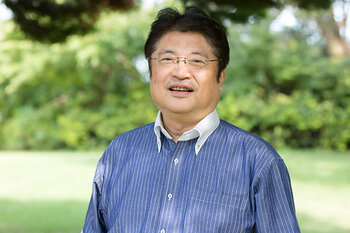High Energy X-rays a Vital Tool to Probe Within Materials
Professor Atsushi Ogura is the director of the Meiji Renewable Energy Laboratory. Meiji University itself was founded in 1881 as a law school and is now one of the oldest and most prestigious universities in Japan.
The Renewable Energy Laboratory was established in 2014 from the Solar Cell Research Unit. This expanded the scope of research from solar cells to a much wider area covering technical issues surrounding renewable energy.
"The research objective of the Meiji Renewable Energy Laboratory is to find solutions for the next generation of renewable energy systems. The research area includes energy creation by photovoltaics, thermoelectric power generators, and other Earth-conscious techniques. It also includes the technical issues associated with the next generation of renewable energy systems, such as energy storage and energy saving. So, we research energy creation, saving, and storage."
This means the laboratory studies everything from renewable energy creation from photovoltaics and thermoelectric devices to high-performance, low energy electronic devices, but also biomaterials like artificial bone materials, and artificial blood vessel materials.
"Our strategy is to improve the performance of devices and structures based on scientific evaluation of materials and the device fabrication processes."
Buried Interfaces Important for Many Areas of Research
The function of many devices is determined by what happens at the interface between materials, such as semiconductor interfaces, metal/semiconductor interfaces, and metal or semiconductor/insulator interfaces. These interfaces are usually buried within the device. One reason is that the surface of a material is extremely sensitive to the atmosphere, which means the surface is usually problematic.
For example, in solar cell devices, sunlight creates electric carriers such as free electrons and holes. But at an exposed surface, the carriers could easily recombine at surface defects, making the device unstable.
"But the device operation should of course be stable. Therefore, the essential structures for the device operation are usually kept away from the surface, covered by other materials."
This means it is essential to evaluate buried surfaces, where the functioning of the device really is determined, to improve the performance of devices such as solar cells or electronic devices.
Hard X-rays Allow You to Look Deeper
To be able to do this, Atsushi Ogura and his colleagues at the Meiji Renewable Energy Laboratory have a hard X-ray photoelectron spectroscopy lab, or HAXPES Lab in short. Ordinary X-ray photoelectron spectroscopy, XPS, allows you to identify elements within a material or on its surface, their chemical state, and the overall electronic structure in the material.
But in XPS, the energy of photons is not high enough to allow scientists to study buried interfaces. Hard X-ray photoelectron spectroscopy, as its name implies, uses more energetic x-ray photons. This enormously improves the researchers' ability to probe deep within the structure they're studying, to see in detail these buried interfaces that are critical to the operation of the device.
No More Queuing at Synchrotron Facilities
Usually, these extremely energetic x-ray photons are produced by a synchrotron facility. But synchrotrons are big machines, and thus not very common, which means obtaining access to a facility is a challenge for researchers.
"Previously, we were always limited by the available beam time at the synchrotron facilities and suffered from long waiting times. The HAXPES Lab has solved this problem for us. Now we can in principle make measurements 24 hours a day, 365 days a year. This has increased our scientific output remarkably."
This is extremely useful for the early feedback to the manufacturing process, Professor Ogura says.
"Rapid feedback is usually essential for speed in research and development, especially in industry, but also in scientific research."
Evaluating What Happens Inside Batteries
Batteries will play a major role in the renewable energy eco-system of the near future. It's also one of the areas that Atsushi Ogura and his colleagues are studying, in order to improve the efficiency of the batteries.
“The essential function in the Li-ion battery is the chemical reaction at the interface between the electrode and the liquid. With the HAXPES Lab we can evaluate what happens at the essential electrode interface within the battery, something we couldn't do with XPS. Detailed evaluation of what happens at this interface should help improve the reliability and efficiency of the battery.”
Teaching the Next Generation
But one of the most important tasks of his group goes beyond producing scientific results.
"The limited access to synchrotron HAXPES means that many scientists are still unfamiliar with the technique. So, one of our most important tasks is to explore the possibilities of home-lab HAXPES and communicate the findings to a broader scientific community."
Another personal driver for Professor Ogura is the next generation of engineers and scientists.
"I am teaching at university. The research, especially the collaboration with industry, is essential for my students. My ultimate goal is to help the students become well-educated engineers and scientists with experience of cutting-edge science such as HAXPES, and to contribute to world industry and peace.”

